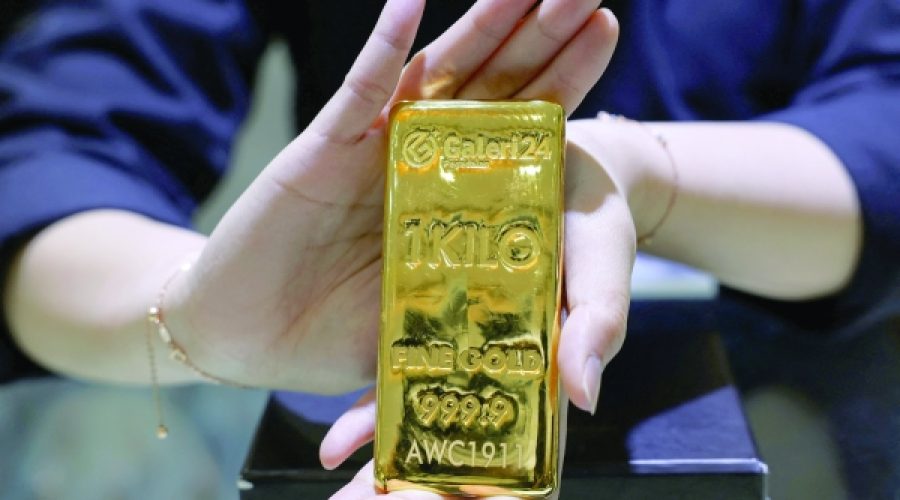Gold’s Record Run: What Investors and Entrepreneurs in Oman Must Know to Navigate Changing Market Rules
LONDON — Investors are challenging traditional beliefs about gold as the metal reaches unprecedented highs, driven by a surge in AI-fueled stocks and a strong performance in bitcoin. Gold recently surpassed $4,000 an ounce for the first time, marking a remarkable 53% gain in 2025 and setting it on course for its best year since 1979. This outpaces bitcoin’s 30% rise and the 15% gain in the S&P 500, which includes prominent tech companies.
Historically, gold has thrived amid investor worries about inflation, economic slowdowns, or market instability. It typically lags behind more liquid and easily held assets when risk appetite improves. For instance, gold surged in 1980 as U.S. inflation soared above 13%, and again in early 2008 during the global financial crisis when the stock market dropped sharply.
However, gold is now rising in tandem with both stocks and bitcoin. This trend reflects investor expectations for U.S. interest rate cuts and growing concerns about the dollar’s status as the world’s leading reserve currency. Arun Sai, senior multi-asset strategist at Pictet, describes gold as the “ultimate debasement hedge” during shifts in the economic system.
Current geopolitical tensions include France’s budget challenges, worries about central bank independence, ongoing conflict in Ukraine, and emerging signs of peace talks in Gaza. Meanwhile, the AI boom propelling Wall Street stocks raises fears of a bubble. Additionally, President Donald Trump’s expansive spending plans, tariffs, and critical stance toward the Federal Reserve have weakened U.S. Treasuries and contributed to a 10% decline in the dollar against major currencies this year. These tariffs have also fueled inflation concerns, further supporting gold’s appeal.
Michael Metcalfe, head of macro strategy at State Street, notes that the market appears to be at an “inflection point for inflation.” Anxiety over Federal Reserve independence and inflation are intertwined concerns driving gold’s demand, amid fears that the Fed may tolerate tariff-driven inflation.
Inflation among G7 countries averaged 2.4% in September, up from 1.7% a year earlier. Most central banks in the group are either cutting rates or maintaining current levels. President Trump has publicly criticized Fed Chair Jerome Powell, attempted to remove a Fed official, and nominated an ally, Stephen Miran, as a governor. Since August, gold prices have climbed about 20%.
As the U.S. labor market slows but other economic data remain resilient, inflation expectations are rising, and traders anticipate rate cuts extending into 2026—benefiting both equities and gold. Rhona O’Connell, head of market analysis for EMEA and Asia at StoneX, explains that gold and stocks can rise together as part of an “efficient frontier” strategy. Gold’s inverse relationship to stocks often makes it a valuable risk mitigator, and strong equity performance can lead managers to increase gold holdings to balance risk while boosting returns.
Gerry Fowler, UBS’s head of equity strategy, highlights growing retail demand as another factor supporting gold prices.
Concerns about a potential AI-driven stock market crash, voiced by the Bank of England and the IMF, also position gold as a hedge against such risks. Trevor Greetham, head of multi-asset at Royal London Asset Management, says investors are “equally bullish about AI as they are about gold.” In the event of a severe recession or a collapse in AI stocks, gold could experience further gains.
The recent surge in gold is largely attributed to weakening confidence in the dollar. Central banks have increased their gold holdings, now making up around a quarter of their reserves, as a strategy to reduce reliance on the dollar. Mark Ellis, CIO of Nutshell Asset Management, expects this trend to continue, with U.S. tariffs encouraging exporters to seek alternative markets.
Summarizing the current gold boom, Ellis simply states, “It’s Donald Trump.”
— رويترز
تحليل خاص من عمانت | تصفح سوق عُمان
The unprecedented surge in gold prices, fueled by geopolitical uncertainties, inflation fears, and the AI-driven stock rally, signals a paradigm shift in global assets that businesses in Oman must monitor closely. This environment presents opportunities for diversification into precious metals as a hedge against potential market volatility and currency risks, especially with the weakening dollar and rising inflation concerns. Smart investors and entrepreneurs should consider balancing portfolios with gold exposure while staying alert to the evolving US economic policies and AI market dynamics that could trigger abrupt shifts in risk appetite.



